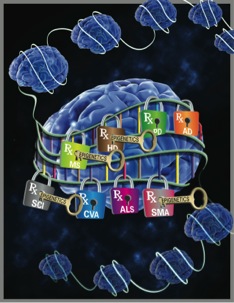Overview
The laboratory is interested in neurodegenerative diseases, with a specific focus on the molecular pathways leading to neuronal damage. We are intrigued by the intercellular communication between neurons and surrounding cells like astrocytes and microglia and we are studying how a miscommunication between astrocytes and neurons/motor neurons contributes to disease progression in Amyotrophic lateral sclerosis and Frontotemporal dementia. To achieve our goal, we are pairing the wet lab to new pipelines of analysis involving -omics data and machine learning approaches. We perform our analysis in in vitro and in vivo systems, and we value the validation in patients. 
Research direction
We are developing two major projects:
-
Deciphering the role of extracellular vesicles in Amyotrophic Lateral Sclerosis and Frontotemporal dementia
On one side we are interested in exploring the mechanisms by which glia-derived extracellular vesicles favor neuronal toxicity, on the other side, we are exploring the use of extracellular vesicles as biomarkers for disease diagnosis and prognosis in neurodegenerative conditions. -
We are collaborating on a project focused on the transcriptional activity of Androgen Receptor in Kennedy’s disease with the aim to defining a possible new therapy.
Group members
- Manuela Basso, PI
- Alice Migazzi, postdoc (Caritro fellowship)
- Paolo Fioretti, PhD student
- Luisa Donini, PhD student
- Silvia Del Longo, Master student
One open position for a pre-doctoral fellow/technician. Please, contact us for any further inquiries.
Collaborations
- Valentina Bonetto, Laura Pasetto, Roberta Pastorelli, Istituto di Ricerche Farmacologiche ‘Mario Negri’
- Andrea Calvo, Università di Torino
- Raffaella Tanel, Ospedale Santa Chiara e Centro NeMO, Trento
- Francesco Rinaldi, Università di Padova
- Maria Pennuto, Università di Padova
- Udai Pandey, University of Pittsburgh
- Laura Tosatto, CNR, Trento
- Alessandro Romanel, Università di Trento
- Vito D’Agostino, Università di Trento
Funding
Bando: PRIN 2022 (D.D. 104/22)
EVALS: Deciphering the role of senescence in glia-to-neuron miscommunication through extracellular vesicles in ALS
Manuela Basso, coordinatrice
Codice Protocollo: 20229HKCRT CUP: E53D23011240006

Selected publications
Pasetto L, Callegaro S, Corbelli A, Fiordaliso F, Ferrara D, Brunelli L, Sestito G, Pastorelli R, Bianchi E, Cretich M, Chiari M, Potrich C, Moglia C, Corbo M, Sorarù G, Lunetta C, Calvo A, Chiò A, Mora G, Pennuto M, Quattrone A, Rinaldi F, D’Agostino VG, Basso M#, Bonetto V#. Decoding distinctive features of plasma extracellular vesicles in amyotrophic lateral sclerosis. # Co-last and co-corresponding author. Molecular Neurodegeneration. 16, 52 (2021). https://doi.org/10.1186/s13024-021-00470-3.
Migazzi A, Scaramuzzino C, Andreson N, Tripathy D, Hernandez I, Grant, Roccuzzo M, Tosatto L, Virlogeux A, Zuccato C, Caricasole A, Ratovitski T, Ross C, Pandey U, Saudou F, Pennuto M, Basso M. Huntingtin-Mediated axonal transport requires arginine methylation by PRMT6. Cell Reports, Volume 35, Issue 2, 108980, 2021.
Tripathy D, Migazzi A, Costa F, Roncador A, Gatto P, Fusco F, Boeri L, Albani D, Juárez-Hernández JL, Musio C, Colombo L, Salmona M, Wilhelmus MMM, Drukarch B, Pennuto M, Basso M. Increased Transcription of Transglutaminase 1 Mediates Neuronal Death in in Vitro Models of Neuronal Stress and Aβ1-42-mediated Toxicity. Neurobiol Dis. 2020 Jul;140:104849. doi: 10.1016/j.nbd.2020.104849. Epub 2020 Mar 25.
Basso M, Chen HH, Tripathy D, Conte M, Apperley KYP, De Simone A, Keillor JW, Ratan R, Nebbioso A, Sarno F, Altucci L, Milelli A. Designing Dual Transglutaminase 2/Histone Deacetylase Inhibitors Effective at Halting Neuronal Death. ChemMedChem. Feb 6;13(3):227-230, 2018. doi: 10.1002/cmdc.201700601.
Tripathy D; Vignoli B; Ramesh N; Polanco MJ; Coutelier M; Stephen CD; Canossa M; Monin ML; Aeschlimann P; Turberville S; Aeschlimann D; Schmahmann JD; Hadjivassiliou M; Durr A; Pandey UB; Pennuto M; Basso M. Mutations in TGM6 induce the unfolded protein response in SCA35. Human Molecular Genetics;26(19):3749-3762, 2017. doi: 10.1093/hmg/ddx259.
Basso M*, Pozzi S*, Tortarolo M, Fiordaliso F, Bisighini C, Pasetto L, Spaltro G, Lidonnici D, Gensano F, Battaglia E, Bendotti C, Bonetto V. Mutant copper-zinc superoxide dismutase (SOD1) induces protein secretion pathway alterations and exosome release in astrocytes: implications for disease spreading and motor neuron pathology in amyotrophic lateral sclerosis. The Journal of biological chemistry 288(22): 15699-15711, 2013. (*first-name coauthorship).
Basso M#, Berlin J, Xia L, Sleiman SF, Ko B, Haskew-Layton R, Kim E, Antonyak MA, Cerione RA, Iismaa SE, Willis D, Cho S, Ratan RR#. Transglutaminase inhibition protects against oxidative stress-induced neuronal death downstream of pathological ERK activation. The Journal of neuroscience : the official journal of the Society for Neuroscience 32:6561-6569, 2012. doi: 10.1523/JNEUROSCI.3353-11.2012 (# corresponding authorship).
McConoughey SJ*, Basso M*#, Niatsetskaya ZV, Sleiman SF, Smirnova NA, Langley BC, Mahishi L, Cooper AJ, Antonyak MA, Cerione RA, Li B, Starkov A, Chaturvedi RK, Beal MF, Coppola G, Geschwind DH, Ryu H, Xia L, Iismaa SE, Pallos J, Pasternack R, Hils M, Fan J, Raymond LA, Marsh JL, Thompson LM, Ratan RR. Inhibition of transglutaminase 2 mitigates transcriptional dysregulation in models of Huntington disease. EMBO molecular medicine 2:349-370, 2010. doi: 10.1002/emmm.201000084. (*first-name coauthorship; # corresponding authorship).
Complete list of publications: https://pubmed.ncbi.nlm.nih.gov/?term=manuela+basso
